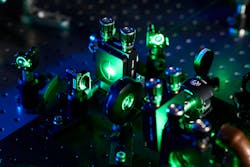Project to develop streamlined laser setup for deep tissue analysis
A collaboration involving ultrafast laser specialist Chromacity (Edinburgh, Scotland), microscope maker Scientifica (Uckfield, England), and Heriot-Watt University (also in Edinburgh) is working together to develop a laser capable of analyzing potentially deadly diseases. The Deep Tissue project has the goal of designing a laser setup that aims to enable greater analysis of biological tissue, including skin, bone, and plant life.
The three-year project builds upon research carried out by Professor Derryck Reid from Heriot-Watt University's Institute of Photonics and Quantum Sciences (IPAQS) to create a laser capable of gathering tissue data to a depth more than double what is presently available on the market, and at around a third of the cost.
"The commercialization of an affordable laser for deep tissue imaging will benefit researchers across the life sciences, including fields such as neuroscience where imaging of the brain through intact mouse skulls has already been demonstrated," says Richard McCracken, a Research Fellow from IPAQS and the project lead. "Many future applications of this technology have not yet been identified due to the prohibitive cost of suitable laser systems, but our collaboration will remove this barrier to development."
Companies—particularly those in medical research—can spend up to £350,000 (just under $437,000) for the nearest comparable laser source. Aside from the high cost, the technology is typically bulky and capable of analyzing up to half a millimeter beneath the surface of biological material.
Recognizing this, the Deep Tissue project aims to deliver a far more streamlined laser that in many cases will double the tissue depth that can be imaged. This emerging class of laser is required for a form of imaging known as three-photon microscopy, in which individual cells can be analyzed in high resolution without damaging surrounding tissue and in a noninvasive manner.
The project would deliver a powerful new tool to the science community, according to McCracken, who says it would open a host of new research areas, including regenerative medicine, leukemia, and Alzheimer’s disease. "The laser can even be used to image into the roots of plants such as rice and wheat, in order to identify bacteria that inhabits growth and help with crop productivity," he adds.
"At present, companies who want to carry out this research must purchase lasers that are capable of doing a variety of analysis, which means additional costs," McCracken continues. "What we want to do is create a laser that is carefully designed to carry out a specialist set of tasks. This means we can develop and invest in the necessary components, allowing us to significantly reduce overall costs while giving the end-user greater scope to carry out their research."
Earlier this year, the project received a major financial boost when it was awarded a £360,000 (over $449,000) research grant from the Science and Technology Facilities Council (STFC; Swindon, England).
A prototype of the laser technology is scheduled for fall 2020.
For more information, please visit chromacitylasers.com, scientifica.uk.com, and hw.ac.uk.
